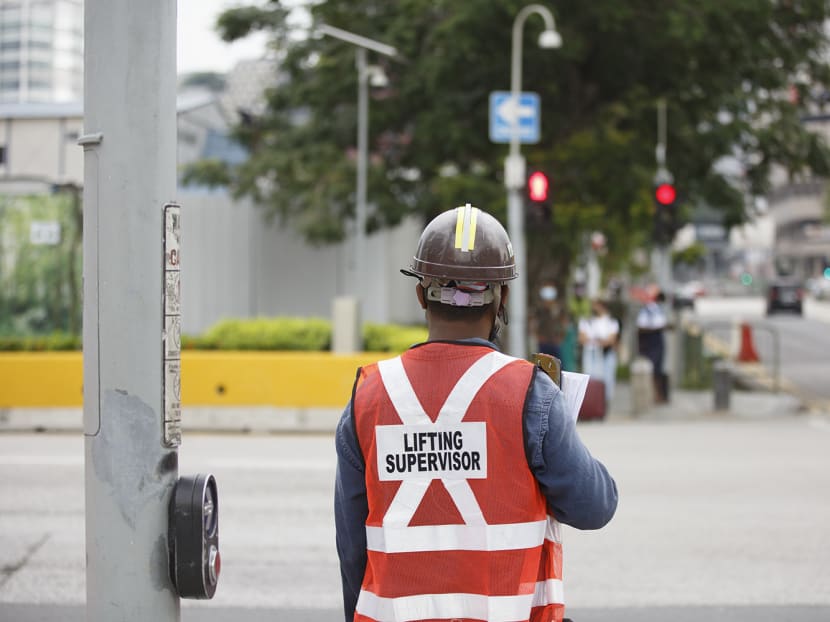Construction firms facing manpower woes despite borders reopening, leaving projects in flux
SINGAPORE — More construction workers are returning to Singapore following the easing of Covid-19 border restrictions, but many are also leaving for home at the same time for their first visit in two years, construction firms say.

- As border controls ease, more construction workers have been entering Singapore to help ease the manpower crunch
- At the same time, many workers are also leaving to go home, the first time in two years for many of them
- Productivity has thus taken a hit with the inflow of less-skilled workers and outflow of more-skilled ones, construction firms said
- New onboarding requirements due to the pandemic have also increased the cost of hiring new workers
SINGAPORE — More construction workers are returning to Singapore following the easing of Covid-19 border restrictions, but many are also leaving for home at the same time for their first visit in two years, construction firms say.
This has left the industry in a state of flux as projects are coming in at a fast pace.
Yet, even with new workers entering, construction firms told TODAY that these workers tend to be unskilled and need to be trained first, and most cannot immediately contribute to ongoing projects.
Onboarding these new workers also comes at a higher cost compared to before the pandemic, for administrative matters such as a stay-home notices and pre-departure Covid-19 tests, the firms said.
STEPS TAKEN TO ALLEVIATE THE LABOUR CRUNCH
The construction sector was badly hit by a manpower crunch during the Covid-19 pandemic, due to the restricted flow of migrant workers into Singapore.
This led to delays in the completion of projects, as well as firms having to increase their quotations as labour costs increased due to the drop in supply.
On May 9, Manpower Minister Tan See Leng said in Parliament that the manpower shortages that have plagued some sectors will likely ease in the coming months with more foreign workers entering Singapore as borders reopen.
"The Government has taken steps to resume the inflow of foreign workers to ease the manpower crunch, and we progressively lifted border restrictions from late last year," he said.
To manage the risk of imported Covid-19 cases at the start of the pandemic, the Ministry of Manpower (MOM) had in March 2020 required all new and existing work pass holders planning to enter Singapore to obtain entry approvals before they arrived here.
Firms and workers previously told TODAY that during the pandemic, these approvals were not guaranteed and some work permit holders had to wait weeks before they could enter Singapore. This resulted in a shortage of workers at that time.
The entry approval requirement has since progressively eased.
In February, it was removed for all fully vaccinated long-term pass holders, but not for work permit holders.
Then, from May 1, MOM removed the requirement for all fully vaccinated non-Malaysian work permit holders holding an in-principle approval in the construction, marine shipyard and process sectors.
All vaccinated Malaysian work pass holders could enter Singapore since December last year through the vaccinated travel lane between the two countries at that time, before land borders opened for fully vaccinated travellers between both countries on April 1.
Mr Akbar Kader, managing director of Nan Guan Construction, said that the removal of the entry approval requirement meant that he could hire more workers, but it also meant that many of them wanted to return to their home countries to see their families.
For many of them, they had not been able to go home for the past two years, because they were afraid that they would not be able to immediately return due to the entry approval requirement at that time.
He said that about 20 per cent of his foreign workforce — comprising largely Bangladeshi and Indian workers — intend to return to their home countries for visits.
He is looking to bring in about 20 per cent more workers to replenish his workforce to pre-pandemic levels and is still in the process of doing so given the recently eased measures.
However, even if manpower is back to pre-pandemic levels, there is a lot more work to be done than before, Mr Akbar said.
"Now we are still feeling the pinch... it’s a double whammy (with) the backlog of projects and the sheer number of projects going into the market due to pent-up demand," he said. "We are hoping that in six months or so, maybe things will stabilise."
Agreeing, executive director and chief operating officer Kenneth Loo from Straits Construction said that although Manpower Minister Tan had said that foreign manpower numbers are almost back to pre-pandemic levels, the "benchmark" has shifted due to lost time on many construction projects.
"There are new jobs (streaming in), as well as projects that were never completed, so the (manpower) requirements are much more," Mr Loo said.
"Because some of the older workers who are perhaps more skilled (have) gone back and there may be (skill) gaps that need to be filled."
The new workers coming in may not be as skilled and so will take time to be trained.
Mr Nelson Tee, managing director of CHH Construction System, said that like Mr Akbar, he has seen about eight to nine out of his more than 30 workers leave to visit home when the entry approvals were removed. In the same time period, he hired six new workers.
"The situation has improved, but the new workers are rookies and are less experienced, so we have to send them for training," he said. "During this period, the skilled people go back and the new come in, so productivity and output will still be affected."
BUSINESS COSTS HAVE RISEN
The increased cost of bringing these workers into Singapore has also caused headaches to the firms, the employers told TODAY.
Ms Foong Yu Han, director of Adf Construction, said that back when entry approvals still had to be sought to bring in workers, the cost of onboarding a new worker could cost as much as S$3,000. The worker would have to serve a 14-day quarantine and go through several Covid-19 tests. These were extra costs that the employer had to pay.
Since March this year, the process of bringing in a worker was streamlined into a shorter two-day pre-departure preparatory programme.
However, a government circular on this new programme stated that firms still had to pay between S$890 and S$1,800 to onboard a new worker, with the cost of their flights included.
The cost includes a two-day stay at a dedicated facility at the worker's home country, a pre-departure Covid-19 test, and a three-day stay-home notice upon arrival in Singapore.
Ms Foong estimated that she has to pay at least S$1,400 a worker under this programme, which is still far costlier than before the pandemic, when employers did not need to bear these costs.
"Before Covid-19, workers could just fly straight to Singapore as long as the in-principle approval was met," she said.
She added that the burden of these fees is fully borne by the employer and the fees cannot be compensated should a worker decide to terminate his contract prematurely.
This poses a problem to construction firms, since some of the new workers will be tasked to complete unfinished projects from before the pandemic, where quotations have already been agreed upon between parties.
Some projects that the company had accepted two years ago did not factor in these extra costs, she explained, adding that the company is still trying to rely on existing workers to try to finish up these projects.
Should there be no other option, Ms Foong said that she will have to utilise the new, more expensive labour.
The silver lining is that there are co-payment options that government agencies such as the Housing and Development Board provides to help defray these extra costs, she said.
Mr Loo from Straits Construction said that these added "onboarding costs" represent just one of the few rising costs the industry is facing.
"The other cost that the industry is more concerned with is rising wage costs," he added. "The (higher onboarding cost) adds up to only one of the many rising costs."








